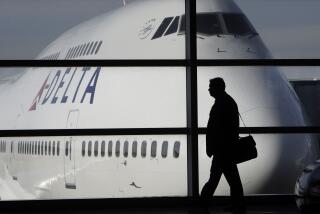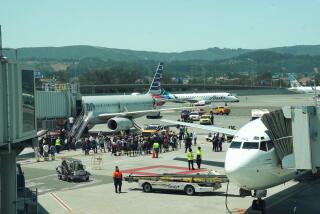FAA grounds entire fleet of Boeing 787s
Federal regulators have grounded all U.S. Boeing 787 Dreamliner passenger jets, a potentially devastating setback for the company’s troubled new flagship airliner.
The move Wednesday by the Federal Aviation Administration left airlines reeling, seeking ways to accommodate delayed passengers. Boeing Co. stock fell on the news in after-hours trading.
The order came Wednesday after a 787 operated by a Japanese carrier, All Nippon Airways, made an emergency landing in southwestern Japan. The crew reported an unusual smell in the cabin, and indicators in the cockpit told pilots there was a problem related to an onboard lithium-ion battery.
FAA statement on Boeing 787 grounding
Such batteries were also involved in a fire last week aboard a parked 787 in Boston operated by Japan Airlines.
The Japanese carriers — which own 24 of the 50 Dreamliners flying today — decided to remove all of their 787s from service indefinitely out of safety concerns. That move led to the FAA’s extraordinary grounding order.
The plane is assembled at Boeing’s Everett, Wash., factory, but the bulk of the large components arrive from suppliers around the world pre-assembled. There are about 50 suppliers in California alone.
“This is clearly a black eye and hiccup for Boeing,” said Richard Phillips, managing director at Janes Capital Partners, an Irvine-based aerospace and defense investment bank. “It’s clearly related to the batteries.... It could mean significant reengineering work that … could take a long time.”
Boeing Chief Executive Jim McNerney said in a statement that the company is working with the FAA to “find answers as quickly as possible.”
“The company is working around the clock with its customers and the various regulatory and investigative authorities,” he said. “We are confident the 787 is safe, and we stand behind its overall integrity.”
The FAA’s decision came less than a week after U.S. Transportation Secretary Ray LaHood and FAA chief Michael Huerta deemed the plane safe to fly. The 787 has experienced a series of mishaps including a fuel leak and the Boston fire. However, the FAA had allowed the planes to continue to operate while it launched an unusual and sweeping evaluation of the way Boeing designs, manufactures and assembles the aircraft.
At issue is the Dreamliner’s electrical systems and power-distribution panels, which involves pervasive use of lithium-ion batteries, which have been involved in fires and can also be found in cellphones and electric automobiles. The Dreamliner is the first large commercial aircraft to use the technology on such a large scale.
In a statement, the FAA said that the grounding order is aimed to “address a potential battery fire risk in the 787 and require operators to temporarily cease operations. Before further flight, operators of U.S.-registered Boeing 787 aircraft must demonstrate to the Federal Aviation Administration that the batteries are safe.”
The FAA order is expected to be followed by carriers worldwide.
Boeing’s use of lithium-ion batteries, made by Kyoto, Japan-based GS Yuasa Corp., were called into question when a smoldering fire was discovered last week on the underbelly of a Dreamliner operated by Japan Airlines after the 173 passengers and 11 crew members had deplaned at the gate.
In the latest incident involving All Nippon Airways, smoke was seen swirling from the right side of the cockpit. All 137 passengers and crew were evacuated from the aircraft and slid down the Dreamliner’s emergency slides. Video of the event was captured by an onboard passenger and has been broadcast worldwide.
FULL COVERAGE: Boeing’s troubled Dreamliner
The FAA has been aware of the flammability of lithium-ion batteries for years. Still when the agency was certifying the Dreamliner for flight operation, it issued special conditions for lithium-ion battery installations on the Dreamliner because regulations don’t cover this technology.
“At present, there is limited experience with use of rechargeable lithium-ion batteries in applications involving commercial aviation. However, other users of this technology, ranging from wireless telephone manufacturing to the electric vehicle industry, have noted safety problems with lithium ion batteries. These problems include overcharging, over-discharging, and flammability of cell components,” the FAA wrote at the time.
The FAA has issued scathing assessments of lithium-ion batteries for starting fires.
In October 2011, the FAA issued an airworthiness directive to owners of Cessna Aircraft Co.’s Model 525C airplanes that required them to swap out the lithium-ion batteries with other batteries.
“We are issuing this … to prevent a potential battery fault that could lead to an aircraft fire,” the directive said.
In a teleconference with reporters last week, Boeing’s chief engineer on the Dreamliner Mike Sinnett said that a lithium-ion battery was not the only choice of battery, but that “it was the right choice.”
“Knowing what I know now, I’d make the same choice,” he said.
Boeing’s stock dropped more than 3%, or $2.60, to $74.34 on Wednesday as it scrambles to fix the $200-million plus planes and rebuild confidence in the flying public.
The force-grounding will probably take a bite out of Boeing’s stock price, at least in the near term, because the company’s identity is tied to the Dreamliner, said analyst Ken Herbert, who covers Boeing for Imperial Capital in San Francisco.
“It confirms a lot of investor fears that the issue was a design issue rather than a production or mechanical issue,” said analyst Ken Herbert, who covers Boeing for Imperial Capital in San Francisco. “Right about now they probably thought they’d be basking in the success of the plane, but these issues keep coming up.”
Herbert said it’s too early to estimate the financial effect of the Dreamliner grounding.
“You’re talking a pretty significant impact, but not necessarily billions of dollars,” Herbert said. “If you start to see a cancellation of orders or a lack of interest from airlines in purchasing this plane in the future, then it’s a much more material impact.”
United Airlines is the only U.S. carrier to operate the 787. In a statement, the airline said it would comply with the FAA grounding order and would work closely with regulators and Boeing.
“We will begin accommodating customers on alternative aircraft,” the statement said.
Boeing said it was working with its customers and the regulatory agencies to get the matter resolved, but it is a public relations nightmare for the Chicago company, which has long heralded the Dreamliner as a representation of 21st century air travel.
Many of these problems are simply the expected issues that emerged with any new plane — especially one as complicated and sophisticated as this, experts said. But problems with new technology such as the new lithium-ion batteries may hold tougher challenges for Boeing.
The Dreamliner, a twin-aisle aircraft that can seat 210 to 290 passengers, is the first large commercial jet with more than half its structure made of composite materials (carbon fibers meshed together with epoxy) rather than aluminum sheets. Another innovative application is that it’s the first large commercial aircraft to make the changeover from hydraulically actuated systems typically found on passenger jets to electrically powered systems involving lithium-ion batteries.
For instance, Boeing has said electric brakes “significantly reduce the mechanical complexity of the braking system and eliminate the potential for delays associated with leaking brake hydraulic fluid, leaking valves and other hydraulic failures.” Because of these technologies, Boeing says, the new plane burns 20% less fuel than other jetliners of a similar size.
Still, investigations into the incidents have not been completed. Scott Hamilton, an aviation industry consultant and managing director of Leeham Co. in Issaquah, Wash., said that all that is known is that there have been fires involving batteries.
“Until we have some causes and fixes … we have to be cautious,” he said.
New planes, in general, have “teething” issues as they are introduced. But the type of review launched last week by LaHood and Huerta was out of the ordinary for a plane that has been in service for more than a year.
The move came despite the “unprecedented” certification process in which FAA technical experts logged 200,000 hours of work over nearly two years and flew on numerous test flights, Huerta said.
“The purpose of the review is to validate the work that we’ve done,” Huerta said at the press conference in Washington, “and to look at the quality and other processes to ensure that effective oversight is being done.”
The Chicago company has taken 848 orders for Dreamliners from airlines and aircraft leasing firms around the world. Depending on the version ordered, the price ranges from $206.8 million to $243.6 million per jet.
“When the government grounds a plane, that has got to concern anyone who flies,” said Joe Brancatelli, an airline expert who writes a regular business travel column. “Think of this as Dreamliner 1.0. There are always problems with the first issue.”
Contributing to this report were Times staff writers Stuart Pfeifer, Peter Pae, Hugo Martin and David Pierson.
More to Read
Sign up for Essential California
The most important California stories and recommendations in your inbox every morning.
You may occasionally receive promotional content from the Los Angeles Times.











